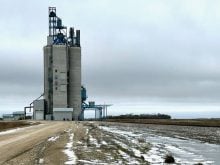COLONSAY, Sask. – Julius and Clara Koopman traded the conveniences of city life in Berlin in 1908 for a sod shack on the virgin prairie in the middle of Canada.
“He (Julius) knew nothing of farming and learned by watching his neighbours,” said the couple’s son Harry Koopman, 93.
“He was told of cheap land, that it was easy and you could make money hand over fist,” he said. “My mother got an awful shock.”
Harry recalled family tales of a big prairie fire and being saved by a large slough to the west of the house.
Read Also

Farming Smarter to hold Agronomy Battles series
Southern Alberta non-profit research institute hope grassroots sessions with producers help focus future research on cover crops, strip tillage and herbicide resistance
He was born in Canada and followed his father’s path, hauling grain with horses by the age of 13.
The first quarter broken by Julius is now part of a nine-quarter farm operated by Harry’s son, Doug. Harry continues to help him at seeding and harvest.
“I just like to help, I don’t get paid,” he joked. “It got into my blood as a kid.”
Harry and his wife Betty raised four children, moving to Colonsay, Sask., in 1947 and to Saskatoon in 1977.
He built a two-bedroom cabin at Colonsay after the original family home was moved off the home quarter so he would have somewhere to rest and eat while commuting from town.
Looking back, he recalled pitching bundles in the early 1930s and thrashing grain for 10 different farmers over a 32-day run at age 20. He always preferred machines to horsepower, acquiring his first combine by 1940.
Crops were poor for eight consecutive years in the 1930s, with wheat as low as 20 cents a bushel in 1932.
“1937 was a complete failure, no rain all summer,” he said.
A wet June and good crop returned in 1939 and a bumper crop was reported in 1942, with the early 1960s and late 1980s bringing dry years again.
Harry said there were years when prices were high and crops were good, but “not too many of those.”
He and Doug said this year got off to an early start in the spring with good moisture and sloughs as big as they have ever seen. However, crops ripened too quickly in the heat of July.
“It’s not as good as it might have been,” Harry said of the barley, wheat, flax and canola.
He recalled wrestling a large boulder from the stony ground 25 years ago with two tractors but being unable to budge it beyond there.
“So we paid a guy to dig a big hole,” he said.
Harry maintained an active community involvement serving on Co-op, sports, municipal and Saskatchewan Wheat Pool boards and participating in curling, bowling and golf.
He said it was hockey and curling that helped him enjoy the severe winters as a boy.
Today, he doubts he would have been among those recommending farming to his father Julius, but he conceded life in Germany most certainly would have taken a turn for the worse. Julius likely would have served in the German army in the First World War and faced life in a shattered city after the Second World War, he said.
Doug said Harry and perhaps Julius also learned to take life in stride, “always looking on the positive.”
“You know there’s bad times and good times,” said Harry. “You got to ride out the bad times and take advantage of the good times.”














